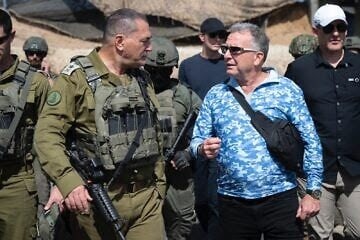The focus, the U.S. president’s son-in-law said, was on shared interests over shared values, and handling disagreements privately.
David Isaac
(JNS)
In an interview with “60 Minutes” host Lesley Stahl that aired on Oct. 19, White House envoys Jared Kushner and Steve Witkoff recounted the chronology of events that led to the hostage-for-ceasefire deal that Israel and Hamas signed in Sharm el-Sheikh, Egypt, on Oct. 9.
Kushner said their approach was rooted in “pragmatic realism,” which he defined as preventing wars through strength and making deals instead of lecturing the world. The focus, he said, was on shared interests over shared values, working with other nations where goals aligned, and handling disagreements privately to reach the best possible outcome.
Witkoff and Kushner said the Israeli airstrike on the Hamas compound in Doha on Sept. 9—which targeted, but didn’t succeed in killing, the Hamas negotiators who were looking over the latest proposals—shredded trust among mediators and nearly capsized talks that, they claim, had been edging toward a deal.
Witkoff said the day before the Israeli strike, on Sept. 8, Kushner and Israeli Minister of Strategic Affairs Ron Dermer were at Witkoff’s home in Florida to review the various peace proposals.
“We woke up the next morning to find out that there had been this attack,” Witkoff recalled. “We felt a little bit betrayed.”
Kushner said he and Witkoff were “very upset” about the attack, which they thought was “not a smart strategic move” and violated the trust they felt they deserved from the Israeli side. He added that U.S. President Donald Trump concluded Israel was “getting a little bit out of control.”
Despite their disappointment at Israel’s action, Kushner and Witkoff concluded that the attack might provide an opening—“perhaps with all of this chaos can come an opportunity,” Kushner said.
They combined a previous ceasefire plan with an “end of war” plan into one document, secured early backing from Qatar and other Arab states, then took it to Trump, who loved the idea and urged them to “go all in.”
The president said they would align the Arab countries first, and “then … figure out how to get Israel on board” to “turn this whole negotiation around,” Kushner said.
The president garnered Arab support when he met with Arab and Muslim leaders at the U.N. General Assembly on Sept. 23. They came out of that meeting with “almost unanimity, consensus support from everybody there,” Witkoff said. “We were talking directly to the people who make the final decisions. And that ultimately became … critical to us being successful.”
On Sept. 29, Israeli Prime Minister Benjamin Netanyahu met with Trump at the White House. The prime minister agreed to the president’s request that he apologize to Qatari Prime Minister and Minister of Foreign Minister Sheikh Mohammed bin Abdulrahman Al Thani for the Israeli airstrike.
Witkoff called it the “linchpin” that enabled the sides to move to the next stage.

That same day, Trump announced his 20-point plan. Kushner explained that by gaining Arab endorsement for the plan, they shifted global pressure from Israel onto Hamas, leaving it “isolated” and compelled to respond. That move, Kushner said, “changed the entire global dynamic,” prompting Arab mediators—Qatar, Turkey and Egypt—to tell Hamas: “It’s time to make this deal.”
Witkoff said it was crucial to include tangible benefits for Hamas in the 20-point plan—including amnesty, Israeli force redeployments, and incoming aid—and that Trump’s personal backing made those guarantees credible. He emphasized that any lasting peace required something for both sides, noting that Hamas members were not required to leave Gaza, a key concession that helped keep negotiations alive.
On Oct. 8, Kushner and Witkoff traveled to Sharm el-Sheikh to meet directly with Hamas negotiators, a meeting they say Trump green-lighted if it could clinch a deal. In the room were representatives from Qatar, Turkey and Egypt, along with four Hamas officials.
Witkoff opened by offering condolences to the Hamas lead negotiator, Khalil al-Hayya, whose son was killed in the Doha strike, and noted he was a bereaved father himself. The exchange, Kushner said, “turned [the room] from a negotiation with a terrorist group to seeing two human beings.”
The bargain struck there called for the return of 48 hostages—20 alive and 28 deceased—in exchange for an agreed ratio of Palestinian prisoners. To address Israel’s central fear of Hamas regenerating, Kushner said Jerusalem accepted a step-down “Yellow Line” redeployment, where it remained in part of the Gaza Strip with further withdrawals conditioned on the creation of an international stabilization force, Hamas disarmament and destruction of its military infrastructure.
In return, Hamas sought guarantees that Israel would be held to commitments once hostages were released. “Given the relations between Israel and Hamas, there was zero trust anywhere to be found,” Kushner said.
Netanyahu invited Kushner and Witkoff to attend the Oct. 10 Israeli Cabinet session that ratified the deal—an impromptu move, Witkoff said, that signaled the prime minister’s support.
Although the Cabinet was supportive, National Security Minister Itamar Ben-Gvir expressed misgivings. “At some point, you got to let it go. We just can’t play the victim all the time,” Witkoff told him.
The Cabinet vote in favor started a 72-hour deadline for Hamas to begin releasing hostages.
Witkoff and Kushner caution that the agreement could fray without rapid progress on security architecture and governance. “Phase one was very hard. Phase two could potentially be even harder,” Kushner said.
Witkoff estimated reconstruction efforts for Gaza will be in the $50 billion range. “It’s rough there because it’s not just rubble, it’s a lot of unexploded munitions all over the field,” he said.
Witkoff and Kushner visited Gaza on Oct. 11. “It looked almost like a nuclear bomb had been set off in that area,” Kushner said.

Both rejected the claims that genocide had been committed. Witkoff flatly rejected the accusation—“There was a war being fought.”
Kushner’s advice to Israel on how to move past global criticism is to focus on being “exceptional.” Those who are friendly to Israel gain from its ingenuity and innovation—“I think that in a couple of years from now, you’ll see Israel going from controversial to very, very popular again on the world stage,” he said.
Image: U.S. envoys Steve Witkoff (center) and Jared Kushner during a visit to the Gaza Strip with Israel Defense Forces Chief of Staff Lt. Gen. Eyal Zamir, Oct. 11, 2025. Credit: IDF.


